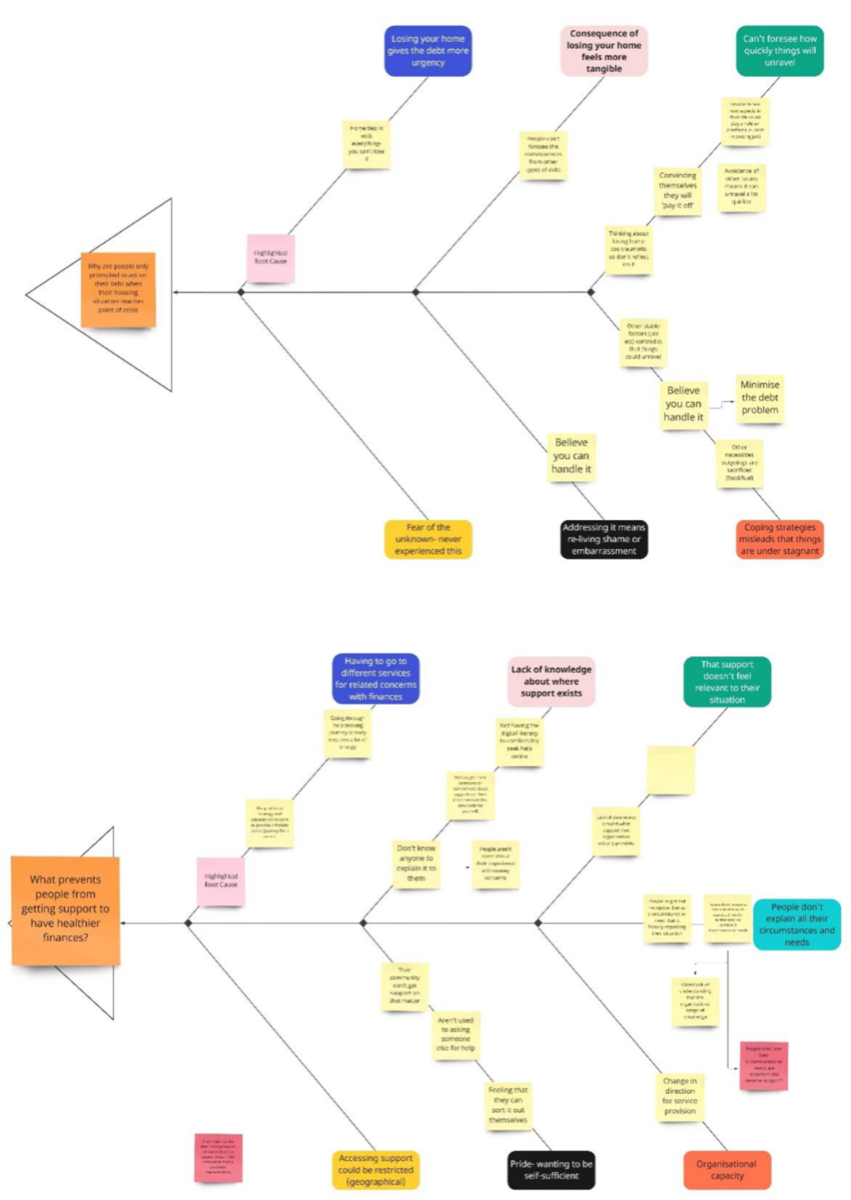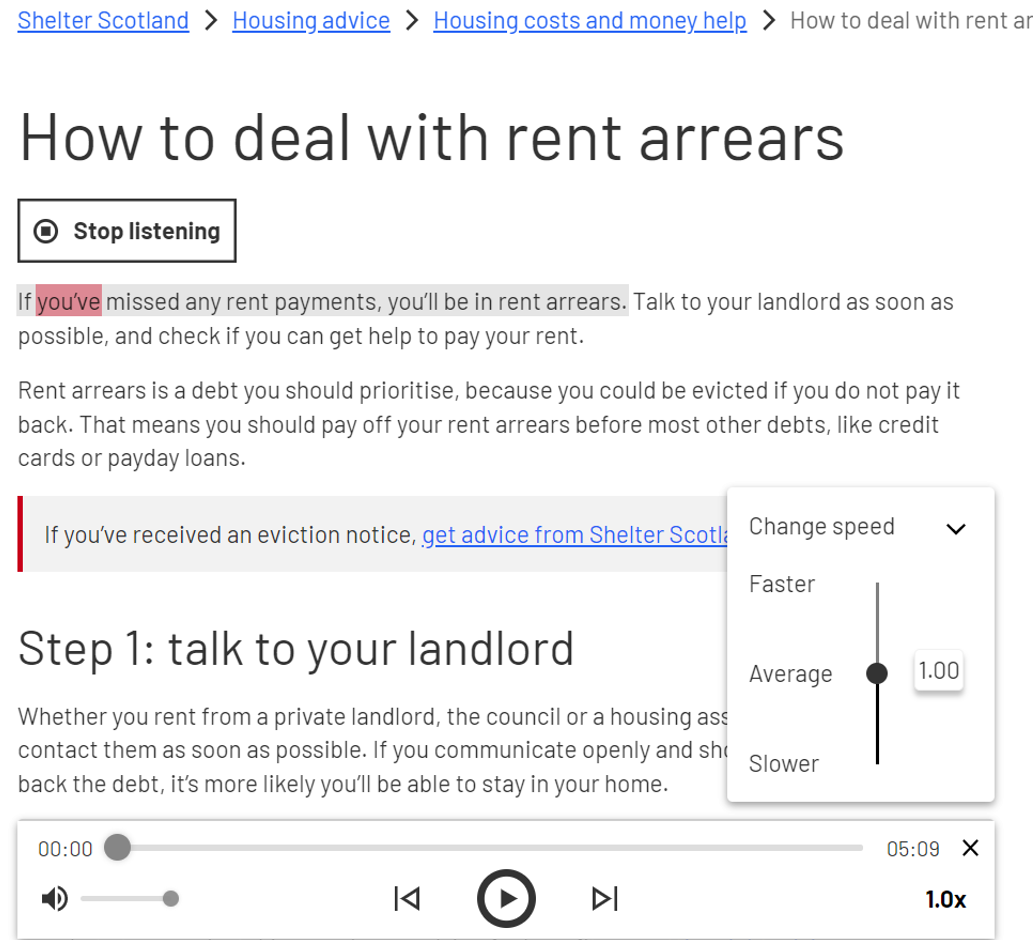Narration Tool
Helping more people access money advice through audio
Overview
People struggling with housing and financial issues often cannot access the advice they need. Dense, text-heavy guidance creates barriers for users experiencing crisis, particularly those with dyslexia or processing difficulties.
The Scottish Legal Aid Board commissioned this project to transform digital access to money and debt advice at Shelter Scotland. COVID-19 made this urgent as traditional support channels closed and financial hardship accelerated.
I joined as the sole UX Designer on a team of specialists including a service designer, 4 content designers, and a money & debt advisor. My role focused on identifying user barriers and translating them into accessible, scalable solutions that could adapt to changing content and legislation.
My Role & Impact
- Led ideation sessions that turned complex user research into clear, testable design directions
- Proposed guerrilla testing methodology that moved the project from discovery into delivery
- Coordinated partnerships with councils across Scotland for contextual testing
- Delivered accessibility tool that enabled neurodiverse users to engage with content they previously found inaccessible
- Provided user research insights that supported content transformation from 123 to 36 pages

Research and Discovery
COVID restrictions created significant recruitment challenges, blocking access to users in authentic advice-seeking contexts. Rather than accept extended timelines, I proposed guerrilla testing in locations where people naturally seek financial advice.
This required coordinating partnerships with councils across Scotland. I secured research access in Dundee and Kirkcaldy libraries, adapting protocols to meet local requirements. This approach proved essential - testing in crisis contexts revealed insights that lab-based research would have missed.
Key Research Findings
I facilitated workshops using fishbone analysis to transform months of qualitative research into actionable design directions. The critical finding was that traditional text-heavy advice created both cognitive and emotional barriers for users experiencing financial stress.
Key insights:
- Dense text overwhelmed users already stressed about financial situations
- Audio and video engagement felt psychologically safer than reading about personal problems
- Users with dyslexia and ADHD faced systematic exclusion from written advice
- Any solution needed automatic updates as COVID emergency legislation changed weekly

Problem Definition and Strategy
How might we remove barriers in advice delivery to help more people access support earlier, particularly during housing crises?
Working with the full team, I facilitated ideation sessions that generated seven concepts, from interactive tools to visual guides to audio narration. My role was establishing evaluation criteria that balanced immediate user impact with technical feasibility during rapid legislative changes.
I developed criteria considering vulnerable user needs, crisis timeline constraints, and scalability without manual intervention. This enabled clear decision-making across different team perspectives and stakeholder requirements.
Audio Narration Solution
Audio narration emerged as the optimal solution, addressing immediate accessibility barriers through four key technical innovations:
Natural Voice Synthesis
High-quality text-to-speech that sounds natural and engaging, avoiding robotic narration that hinders comprehension.
Speed Control
Users can adjust playback speed to match their processing needs, giving them control over their experience.
Text Highlighting
Visual indication of current audio position helps users follow along and provides context for better comprehension.
Streaming Architecture
Real-time text processing enables automatic updates without manual intervention, crucial for rapidly changing legislation.
Testing and Validation
Concept Validation
I tested low-fidelity prototypes across six remote sessions to validate core assumptions before technical investment.
Key insights
- Users wanted natural-sounding voices
- Speed control was essential
- Robotic narration hindered comprehension
Contextual Testing
Guerrilla testing across Dundee and Kirkcaldy libraries provided insights unavailable through traditional methods.
Key findings
- Dyslexia/ADHD users found audio easier to process
- Helpful without glasses, whilst multitasking
- Text highlighting needs identified
Pre-launch Validation
Final testing with five users, with at least half identifying as neurodiverse, confirmed the solution was ready for launch.
Key outcomes
- Widely appreciated by all participants
- Text highlighting effective for context
- Ready for launch validation
It's giving you advice and help and doing it in a way that's really easily understandable.
Accessibility Impact
The narration tool addressed specific accessibility challenges identified through user research, particularly for neurodiverse users experiencing financial crisis.
Cognitive Load Reduction
Audio processing bypassed reading barriers for users with dyslexia and ADHD, making complex financial advice accessible during crisis moments.
Crisis-Appropriate Design
Gentle audio delivery reduced emotional stress compared to dense text when facing housing emergencies.
User Agency
Speed control and text highlighting gave users control over their experience during vulnerable moments.
Technical Implementation
Advocating for streaming technology, I worked with developers to implement streaming audio rather than static files. This technical decision proved crucial when emergency rent legislation required weekly content updates. While pre-recorded audio would have needed constant recreation, our streaming approach adapted automatically.
I established this architecture early, recognising that the operational context required flexibility that traditional approaches couldn't provide.
Implementation and Launch
I coordinated launch strategy starting with the rent arrears advice page, selected through collaboration with the money & debt advisor and content team. This approach demonstrated value before expanding across the broader advice section.
The launch required balancing different perspectives and timelines. Content designers needed specific outputs for restructuring work, whilst the service designer focused on system-wide implications. The money & debt advisor provided practical constraints that shaped implementation approach.
When COVID restrictions continued affecting research, I led methodology adaptation that maintained user-centred delivery despite external constraints.

Live Implementation
The narration tool successfully launched on the Rent Arrears advice page, demonstrating the streaming architecture's effectiveness. Users could adjust playback speed and navigate through complex housing advice content with full accessibility control.
Outcomes and Impact
Based on strong user engagement evidence, we expanded the narration tool across the entire money and debt section. I established success criteria that prioritised engagement quality over volume, recognising accessibility tools serve specific needs rather than mass adoption.
My research insights informed the content team's restructuring work, improving overall accessibility across the advice platform. The contextual research approach became a template for future studies during external constraints.
The project demonstrated that accessibility innovation during crisis can drive organisational efficiency whilst serving users who need support most.
Strategic Insights
Four key learnings that shaped my approach to design leadership and crisis innovation.
Crisis methodology adaptation
Recognizing when projects need methodological innovation can unlock delivery momentum beyond standard approaches.
Multi-stakeholder coordination
Managing relationships across multiple councils whilst leading a cross-functional team showed how complex coordination enables innovation under pressure. Each stakeholder had different needs, but alignment enabled successful outcomes.
Technical decisions with operational impact
The streaming architecture choice demonstrated how accessibility requirements can solve broader operational challenges. This approach proved valuable for any environment requiring frequent updates whilst maintaining user experience.
Accessibility as efficiency driver
Solutions designed for users with the highest needs often improve experiences broadly whilst building organisational capability for crisis response.